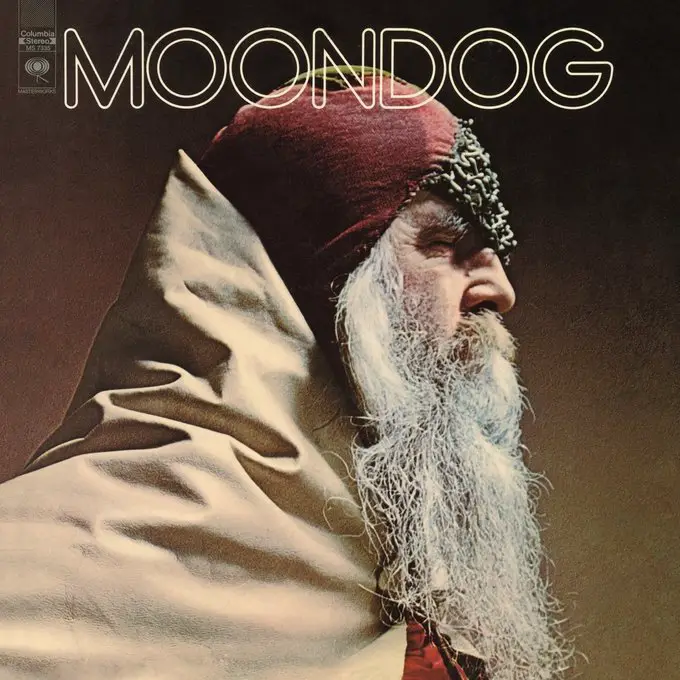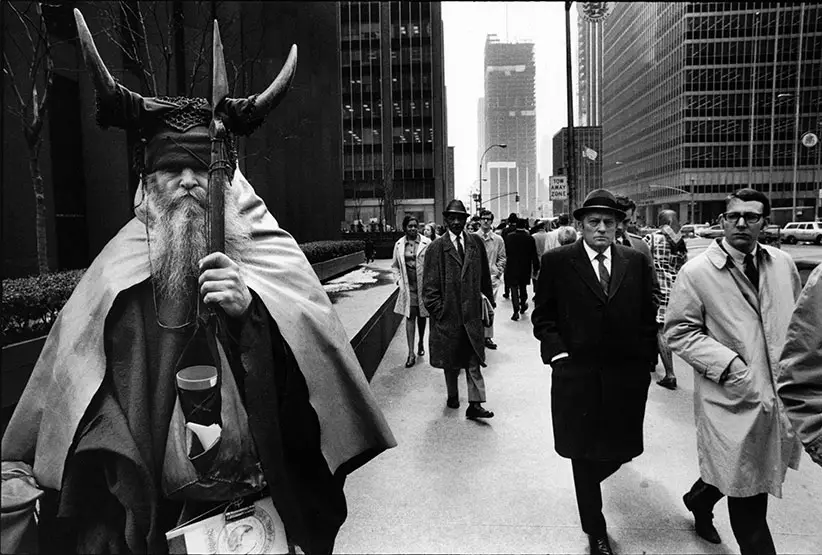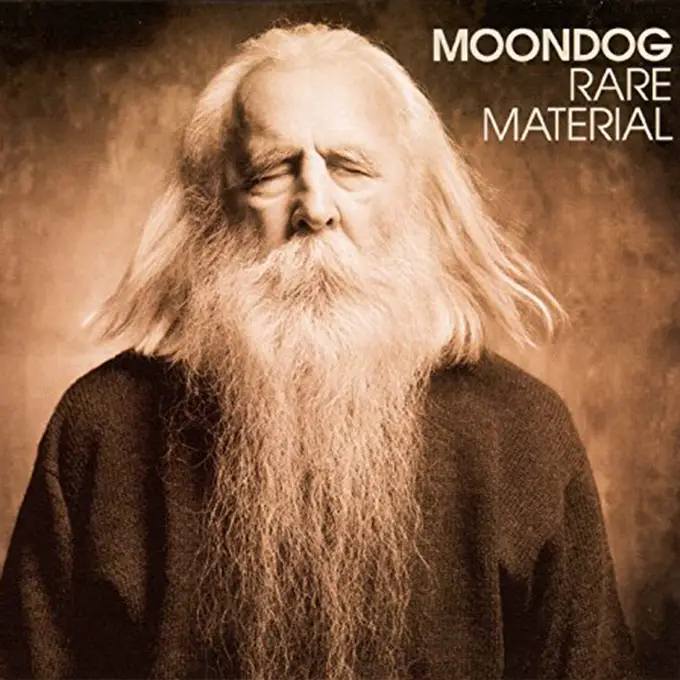No, this Moondog had no connection to The Doobie Brothers or their song. He did though have a connection with the streets. Particularly those of New York, to which, for a big part of his life he took his music. From the late ’40s to the late ’60s, he was mostly on a street corner close to Carnegie Hall. All the musicians in New York would pass by, and so would half of New York on any given day.
The musicians would notice his music played an array of self-made instruments and passerby would be taken aback by a blind man over six feet tall with long hair and beard, dressed in a homemade Viking garb, moving his fingers rapidly under his cloak or three lines of coats during winter. He was composing in Braille. He became such a fixture that he was often mentioned as a New York tourist attraction.

Many who noticed him thought that his music would never be heard, without realizing that they have probably heard it, and by a wide array of musicians who played his songs or compositions or those that shared a stage or collaborated with him. So who was this distinctive figure, composer, musician, instrument inventor who went under the name of Moondog?
Howling at the Moon
How did Louis Hardin, born in Marysville, Kentucky become a blind musical genius that went under the name Moondog? Walking down a long and winding road from an Arapaho reservation in Wyoming, where his father, a Episcopalian minister, was always on the move with his family running a trading post.
Louis was blinded at 16 when a dynamite cap he was playing with exploded in his hands. With his senses focused on other senses, he got fascinated with the music of Native Americans and enrolled into Iowa School for the Blind, where he studied music. New York was the music center at the time and that is where Hardin wanted to be. But how does an aspiring musician who spent most of his early life wandering around the provincial towns and outposts succeed in a bustling megalopolis that was New York, even back in 1943?
…he decided that is where he had to be, but located close to the source of music, and that source was Carnegie Hall.
Get noticed somehow. Harding first decided to change his name. He became Moondog, after a family pet that was constantly howling at the moon. After all, it spoke a lot about him. New York streets fascinated him so he decided that is where he had to be, but located close to the source of music, and that source was Carnegie Hall. So he located himself, his instruments, Braille composing tool, and his music at the corner of 51st Street and Sixth Avenue, close to Carnegie. Arthur Rodzinski, then the conductor of New York Philharmonic, noticed Moondog (hard to miss at over six feet tall) hanging constantly at The Hall’s musician’s entrance and invited him to rehearsals. When Moondog presented some of his music to him, Rodzinski offered to conduct an orchestral work of Moondog’s. Since Hardin had no money, he had no chance to prepare the parts for orchestra.
At the time Rodzinski left in 1947, Moondog started wearing the Viking garb. As he later explained himself, he did that because passerby on the street compared him to Jesus. “I put up with that for a few years, getting compared with a monk or Christ,” he later recalled in an interview. “Then I said, ‘That’s enough, I don’t want that connection. I must do something about my appearance to make it look un-Christian.’” At the time, Hardin was intensely interested in Nordic mythology, so he decided he’d alter his appearance to show his devotion.
That certainly didn’t win him any favors. His rehearsal privileges got revoked and he was bound to the streets. He later told the New York Times: ”I had a lot of offers from people who said that they would help me but that I had to dress conventionally, but I valued my freedom of dress more than I cared to advance my career as a composer. I just wanted to do my own thing, and no matter how much it cost me in terms of my career, I did it.”

Streets Lead to Somewhere, After All
Playing his music on home-made percussion and reeds can get you noticed. Calling yourself Moondog and being an over six-foot tall blind man dressed as a Viking helps too. But that could only be a brief novelty unless your music was worth something. And besides Rodzinski and Arturo Toscanini (another Philharmonic conductor), other musicians, like jazz giants Charlie Parker, Dizzy Gillespie, and Benny Goodman, recognized the quality of Moondog’s music. Shortly before his death, Parker told him on one occasion, “You and I should make a record together.” It never happened.
But Moondog got noticed by record producers anyway and his recordings started appearing in the ’50s. As Zachary Crockett notes in Priceonomics, “In the early 1950s, a young Cleveland disc jockey named Alan Freed got his hands on a copy of ‘Moondog Symphony,’ and was instantly obsessed with it. He began calling his show The Moondog House. He used Moondog’s name, album, and music without permission. The word got to Moondog, and he filed a court injunction.”
…a young Cleveland disc jockey named Alan Freed got his hands on a copy of ‘Moondog Symphony,’ and was instantly obsessed
“Despite the fact that Moondog’s works were not copyrighted, he was awarded $6,000 in personal damages, and Freed was forced to discontinue the use of ‘Moondog’ — largely thanks to Benny Goodman who had come to Moondog’s defense.”
Losing, Freed decided to name his show “rock and roll” and the rest is history. On the other hand, in his gratitude, Moondog later recorded tributes both to Benny Goodman (“Good For Goody”) and Charlie Parker (“Bird’s Lament”), some of his best-known compositions. The latter is still one of the most sampled tunes around.

While jazz musicians like Parker, Goodman, and Gillespie quickly recognized the excellence of Moondog’s music, the classical establishment wasn’t that quick. Many cite British music critic Kenneth Ansell who later on observed that Count Basie and Parker admired “Moondog’s idiosyncratic forays into their world, the classical orthodoxy has not rushed to embrace him.”
But then, as the ’60s came in, as Robert Scotto (author of Moondog) wrote, he became a huge influence on some modern classical composers he actually worked with – Steve Reich and Philip Glass. Moondog actually lived with Glass’ family for a year.
As Glass recalls, “He’d stand in the stairway to the jazz club Birdland and play along with anything they were playing inside the club. I was amazed at his facility for doing this, and the way he could make music of found sounds. I remember him standing on the roof overlooking the Hudson River, and when Queen Elizabeth pulled into port, blowing its horn, Moondog would toot along with it on his bamboo flute.”
From the Streets to Philharmonic and Rock Stages
Hardin was recorded during the ’50s, but his recordings truly became available when, in the late ’60s, Chicago (then called Chicago Transit Authority) producer James William Guerecio took him to Columbia Records, for whom Moondog recorded “Moondog” and “Moondog 2”, probably his best-known records.
Wider audience and recognition did arrive, with the likes of Julie Andrews and Janis Joplin recording his songs. Joplin recorded his composition “All Is Loneliness” with Big Brother & The Holding Company, and Hardin had this verdict about it: “She murdered it.”
Then Moondog started getting invited to the stage, sharing it with the likes of Ravi Shankar, Elvis Costello, Lenny Bruce, Salvador Dali, William Burroughs, Tiny Tim, Allen Ginsberg, and the list goes on. Later on, his works were used for known movie soundtracks, from Big Lebowski to Pineapple Express.
In 1974 Moondog went to Germany to attend the first European concert of his works. He stayed, again, starting out playing on the streets of Hamburg. As Dave Laing wrote in Moondog’s obituary in The Guardian, there “he met Ilona Goebel, an archeology student, who became his amanuensis, publisher, record producer, and companion. She also persuaded him to give up the Viking regalia.” His composing remained prolific. Laing notes that in 1984 he wrote his first symphony, five years later “he was supervising the performance of his 50th.”
…in 1984 he wrote his first symphony, five years later “he was supervising the performance of his 50th.
“There was a belated recognition of his achievement and that of another American eccentric, Conlon Nancarrow when the composers and their works were featured at the New Music America Festival in New York in 1989. On this occasion, Moondog’s conducting style was as idiosyncratic as his compositions: he sat to the side of the orchestra beating time on a bass drum.”
John Strausbaugh neatly defines Moondog’s music – “he wrote in an impressively wide range of styles: percussion-driven exotica (he made his own triangular drum-and-cymbal instrument, the trimba), avant-garde jazz, folkish madrigals, Bach-like neo-Baroque rounds and canons for chamber orchestra, symphonies for full orchestra, and layered minimalism.” His recorded or non-recorded works keep constantly cropping up. Laing mentions “Cosmos”, a nine-hour piece that envisions the participation of a thousand musicians and singers. It remains unperformed.
The range of his self-made instruments “included the ‘uni’, a seven-stringed zither; the ‘utsu’, a rudimentary type of keyboard tuned to the pentatonic scale (the same intervals of the black keys on a piano); the ‘tjui’, a series of nine tuned wooden pegs, and the ‘oo’, a triangular 25-stringed harp.
The legacy of Moondog, whom many still label as only “the New York street musician”, is still something that is yet to be fully discovered.




